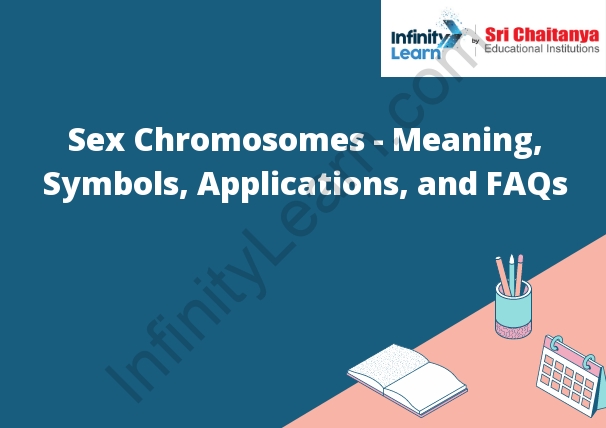Table of Contents
Sex Chromosomes Definition Biology or Define Sex Chromosomes; Differentiation;
Sex chromosomes are chromosomes that determine a person’s sex. Females have two X chromosomes, while males have one X and one Y chromosome. Sex chromosomes are different from other chromosomes because they are not always the same in males and females. Other chromosomes are the same in both males and females.

Female Chromosome Symbol
The female chromosome symbol is XX. This symbol represents the fact that females have two X chromosomes in their cells. Males, on the other hand, have one X and one Y chromosome.
Male Chromosome Symbol
The male chromosome symbol is XY. This stands for the chromosomes that are found in the male sex cells. Females have two X chromosomes, while males have one X and one Y chromosome. The Y chromosome is responsible for the development of the male sex characteristics.
Sex Determination
The sex chromosomes are the X and Y chromosomes. Females have two X chromosomes, while males have one X and one Y chromosome. The sex of a baby is determined by the sex chromosomes it inherits from its parents. A baby inherits one sex chromosome from its mother and one from its father. If the baby inherits an X chromosome from its mother and a Y chromosome from its father, the baby is a boy. If the baby inherits a Y chromosome from its mother and an X chromosome from its father, the baby is a girl.
Symbols
Symbolically, the X and Y chromosomes represent the two halves of the same coin. They are both essential components of human life and yet contain very different genetic information. The X chromosome is seen as the female half of the coin, representing femininity and the maternal role in reproduction. The Y chromosome is seen as the male half of the coin, representing masculinity and the paternal role in reproduction.
The X and Y chromosomes are often used as symbols to represent the differences between males and females. They are also used to illustrate the importance of understanding the genetic and biological components of gender. By understanding the differences between the two sex chromosomes, we can better understand the complexities of gender identity and how it affects our lives.
Applications
The applications of sex chromosomes are numerous. In medicine, the sex chromosomes are used to diagnose and treat certain conditions and diseases. For example, sex chromosome aneuploidy (SCA) is a condition in which an individual has an extra or missing sex chromosome. This can lead to a variety of physical and mental problems, including infertility and learning disabilities. By testing for SCA, doctors can diagnose and treat these conditions as early as possible.
In addition, genetic testing is used to determine an individual’s sex before they are born. This is done by testing either the mother’s blood or the fetus’s cells for the presence of the Y chromosome. This can be helpful for couples who have a known history of sex chromosome disorders.
In forensics, sex chromosomes are used to identify the sex of a person, even after death. This is done by extracting DNA from a sample of bone or tissue and testing for the presence of the Y chromosome. This can be extremely helpful in identifying victims in cases of sexual assault, murder, or other violent crimes.
Finally, sex chromosomes are also used in research. They are used to study the differences between the sexes, as well as how sex chromosomes affect various traits, such as behavior and intelligence. This can help us better understand how the sexes are different and how we can better understand and treat diseases and disorders.
In conclusion, sex chromosomes are an incredibly important part of life and have many applications in medicine, forensics, and research. They can help us diagnose and treat certain conditions, identify victims in cases of violent crime, and better understand the differences between the sexes.
FAQs
Q1: What is a sex chromosome?
A sex chromosome is a type of chromosome that helps determine the sex of an individual. In humans, there are two types of sex chromosomes, the X chromosome and the Y chromosome. Females typically have two X chromosomes while males typically have one X and one Y chromosome.
Q2: What is the difference between the X and Y chromosomes?
The X chromosome is much larger than the Y chromosome and contains more genes. The Y chromosome is much smaller and contains fewer genes. The X chromosome contains many genes involved in the development of female characteristics while the Y chromosome contains many genes involved in the development of male characteristics.
Q3: How do sex chromosomes affect the development of an individual?
Sex chromosomes affect the development of an individual in a number of ways. One of the most important roles that sex chromosomes play is in the determination of the individual’s sex. For example, if an individual has two X chromosomes, they will typically develop as a female, while if they have an X and a Y chromosome, they will typically develop as a male. Sex chromosomes also affect other aspects of development including the individual’s physical characteristics, such as height and eye color.
Q4: Are there any other types of sex chromosomes?
In some species, there are more than two types of sex chromosomes. For example, in some birds, there are three types of sex chromosomes, the W, Z, and U chromosomes. In some reptiles, there are five types of sex chromosomes. These additional types of sex chromosomes allow for the potential for more complex sex determination systems.









